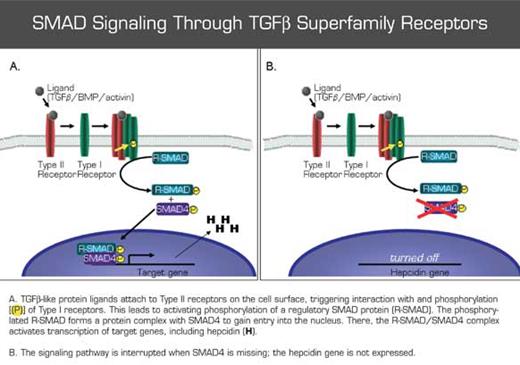Hepcidin is a potent peptide hormone that controls body iron distribution by turning off intestinal iron absorption and sequestering iron in tissue macrophages. Genetic hemochromatosis results from too little hepcidin production and consequent increases in dietary iron absorption and serum iron levels (Figure 1). In contrast, most features of the anemia of inflammation can be attributed to increased hepcidin production, induced by inflammatory cytokines (Figure 1). In spite of these clear associations, we understand relatively little about the molecular controls that determine how much hepcidin is made. In this article, Wang and colleagues report a surprising link between hepcidin gene expression and a classical molecular signaling pathway with prominent roles in development. They show that genetic removal of the protein SMAD4 from the liver cells interrupts hepcidin production and causes a hemochromatosis-like disease in mice.
SMAD4 is an essential component of cellular signaling pathways activated by binding of transforming growth factor β(TGFβ) ligands to their cell surface receptors. These pathways control cell proliferation, differentiation, and apoptosis in diverse processes from development to wound healing. Along with classical TGFβs, this signaling paradigm is used by bone morphogenetic proteins (BMPs) and activins. There are multiple TGFβ-like receptors and a host of cytoplasmic, receptor-activated regulatory SMADs (R-SMADs) that transduce their signals. But SMAD4 is unique because it is required by all of these pathways, interacting with R-SMADs to bring them into the nucleus to modulate gene transcription (Figure 2). Remarkably, removing SMAD4 from adult liver cells causes hemochromatosis. The powerful implication of this study is that hepcidin transcription is controlled by TGFβ-type signaling BE we just don't know which TGFβ-like ligands or receptors do the job. Could human SMAD4 mutations be another cause of clinical hemochromatosis? Very unlikely, because loss of SMAD4 function throughout the body is probably not compatible with life. So far, there are few clues as to how TGFβ signaling relates to the three proteins, HFE, TFR2, and hemojuvelin, which are known to be mutated in human hemochromatosis patients. Undoubtedly, new insights will develop over the coming year.
Competing Interests
Dr. Andrews indicated no relevant conflicts of interest.


